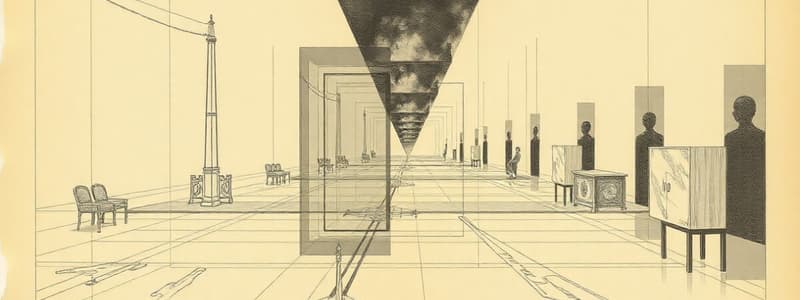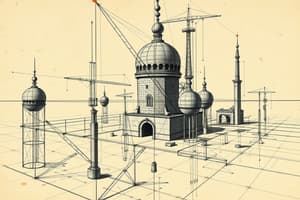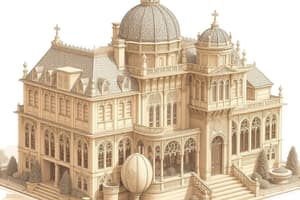Podcast
Questions and Answers
Which of the following shapes has no edges?
Which of the following shapes has no edges?
- Cube
- Sphere (correct)
- Prism
- Cylinder
A surface can be both plane and curved.
A surface can be both plane and curved.
True (A)
What is the primary purpose of using a hidden line in multiview drawings?
What is the primary purpose of using a hidden line in multiview drawings?
To show the existence of a hidden edge.
A surface is bounded by edges or a surface limit, which can be classified as ________ or ________.
A surface is bounded by edges or a surface limit, which can be classified as ________ or ________.
Match the following terms with their descriptions:
Match the following terms with their descriptions:
What is the purpose of orthographic projection?
What is the purpose of orthographic projection?
Parallel projection lines can only be normal to the plane of projection.
Parallel projection lines can only be normal to the plane of projection.
What is meant by 'line of sight' in projection theory?
What is meant by 'line of sight' in projection theory?
In orthographic projections, the image created on the projection plane depends on the object's _____ to the plane.
In orthographic projections, the image created on the projection plane depends on the object's _____ to the plane.
Match the following types of view with their advantages:
Match the following types of view with their advantages:
Which of the following statements about projections is correct?
Which of the following statements about projections is correct?
Axonometric drawing is a type of multiview drawing.
Axonometric drawing is a type of multiview drawing.
Name one advantage of using multiview drawings.
Name one advantage of using multiview drawings.
What is the primary outcome of shape and angle distortion in perspective drawing?
What is the primary outcome of shape and angle distortion in perspective drawing?
Multiview drawing requires viewing an object from different angles.
Multiview drawing requires viewing an object from different angles.
What dimensions are necessary to describe an object in multiview drawing?
What dimensions are necessary to describe an object in multiview drawing?
In drawing, a ______ is defined as a line that represents the boundary between two faces of an object.
In drawing, a ______ is defined as a line that represents the boundary between two faces of an object.
Which method is NOT used in multiview drawing?
Which method is NOT used in multiview drawing?
Match the following views to their corresponding descriptions:
Match the following views to their corresponding descriptions:
In perspective drawing, sizes and shapes appear distorted.
In perspective drawing, sizes and shapes appear distorted.
What is the purpose of the 'glass box' concept in drawing?
What is the purpose of the 'glass box' concept in drawing?
What concept is used to understand the projection of inclined lines and planes?
What concept is used to understand the projection of inclined lines and planes?
An oblique line projection is the same as a normal line projection.
An oblique line projection is the same as a normal line projection.
What is the function of a miter line in projection drawings?
What is the function of a miter line in projection drawings?
Curved surfaces can either tangent or ______ with an adjacent plane or curve surface.
Curved surfaces can either tangent or ______ with an adjacent plane or curve surface.
Match the following types of projections with their descriptions:
Match the following types of projections with their descriptions:
How do you transfer depth in projection drawings?
How do you transfer depth in projection drawings?
In multiview drawings, it is preferable to have no space between front and side views.
In multiview drawings, it is preferable to have no space between front and side views.
What is a key characteristic of a curve line projection?
What is a key characteristic of a curve line projection?
What should a hidden line do when it joins a visible line?
What should a hidden line do when it joins a visible line?
A curve hidden line can start on a center line.
A curve hidden line can start on a center line.
What are the four corner formations that can be created at the intersection of hidden lines?
What are the four corner formations that can be created at the intersection of hidden lines?
A center line should always start and end with a _____ dash.
A center line should always start and end with a _____ dash.
Match each term to its definition:
Match each term to its definition:
How should a center line be presented when depicting a small hole?
How should a center line be presented when depicting a small hole?
A center line can extend between views.
A center line can extend between views.
When a center line forms a continuation with a visible or hidden line, a _____ should be left.
When a center line forms a continuation with a visible or hidden line, a _____ should be left.
What is the purpose of a lug in an object?
What is the purpose of a lug in an object?
A spoke is defined as the flat, thin feature of an object that acts as structural support.
A spoke is defined as the flat, thin feature of an object that acts as structural support.
What is meant by an 'aligned section'?
What is meant by an 'aligned section'?
The ________ is a thin, flat feature of an object that acts as a structural support.
The ________ is a thin, flat feature of an object that acts as a structural support.
When should section lines be omitted in a section view?
When should section lines be omitted in a section view?
Match the following terms with their definitions:
Match the following terms with their definitions:
Conventional breaks are used to omit parts of an object that are not important in order to fit long objects onto a drawing medium.
Conventional breaks are used to omit parts of an object that are not important in order to fit long objects onto a drawing medium.
What happens to the appearance of holes when viewed in an aligned section?
What happens to the appearance of holes when viewed in an aligned section?
Flashcards are hidden until you start studying
Study Notes
Orthographic Projection
- Orthographic projection graphically represents a 3D object on 2D media like paper or a screen.
- It utilizes lines of sight (LOS) and a plane of projection to create an image.
- Lines of sight can be parallel or convergent, with parallel projection being further categorized as orthogonal or oblique.
- Orthographic parallel projection is the focus of this study.
Multiview Drawing
- Multiview drawing involves creating multiple related images of an object from different perspectives.
- Adjacent views provide depth, height, and width information for a complete representation.
- Multiview drawing relies on the "glass box" concept, which involves rotating the object relative to the observer or moving the observer around the object.
- Views include top, front, right side, left side, rear, and bottom.
Object Features
- Edges represent the boundary between two faces of an object.
- Surface limits denote the last visible part of a curved surface.
- Surfaces are areas bounded by edges or surface limits and can be either plane or curved.
Projections
- Projections of normal lines, planes, and objects are created by following the principles of the glass box concept to define visibility and hidden lines.
- Inclined and oblique lines and planes require careful consideration of angles and their projection onto different view planes.
- Curved lines and surfaces are also projected, with the glass box concept used to accurately represent their form.
Hidden Line Drawing
- Hidden lines are used to indicate the existence of edges or features that are not visible from a given viewpoint.
- Hidden lines should typically join visible lines except when extending from a visible line.
- Intersections between hidden lines should form L, T, V, or Y corners.
- Curve hidden lines should begin on a center line.
Center Line Drawing
- Center lines are used to represent the center of circles, arcs, and symmetrical features.
- They begin and end with a long dash.
- In circular views, the short dash of a center line should cross at the center of the circle or arc.
- Center lines do not extend between views.
- For small holes, center lines are represented as thin continuous lines.
Transferring Depth
- Depth information can be transferred between views using either direct measurement or the "miter line" method.
- The miter line method requires drawing a line at a 45-degree angle to transfer depth information.
Projections with Curved Surfaces
- When an object has both curved and plane surfaces, careful consideration is needed to represent how the surfaces interact.
- Lines are annotated as "V" for visible, "H" for hidden, and "C" for center lines.
Section View Representation
- Rib, Web, Spoke and Lug are structural features that can be represented in section view.
- Ribs and Webs are thin, flat features that act as structural support.
- A Spoke is a rod that radiates from the hub to the rim of a wheel.
- A Lug is an ear (or projection) built as part of an object for attachment.
Conventional Practice
- Omit section lines on the section view of ribs, webs and lugs when the cutting plane passes through them flatwise.
- Omit section lines on the section view of spokes when the cutting plane passes through them lengthwise.
Aligned Section
- An aligned section is a section view drawn by imagining the object’s features rotated about a symmetry axis.
- This technique helps to show features that would otherwise appear distorted or misleading in a standard section view.
Conventional Break
- A conventional break is used to represent long objects that need to be drawn at a smaller scale to fit on the paper.
- The long portion of the object, which contains no important information, is removed and break lines are drawn at the broken ends.
Studying That Suits You
Use AI to generate personalized quizzes and flashcards to suit your learning preferences.




